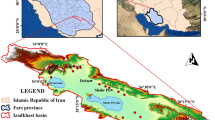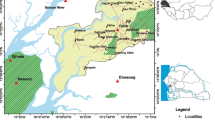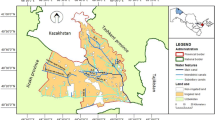Abstract
Sundarbans in West Bengal, India, located in the eastern coast of the Bay of Bengal is one of the vulnerable islands subjected to abrupt climate change. The consequence of climate change is of particular importance because of its closeness to sea leading to sea water intrusion. Sea water intrusion not only affects the soil salinity and groundwater quality but also changes the salt dynamics of the region, hampering crop yield due to accumulation of salt in the root zone. The present study assessed the spatio-temporal changes in salinity of soil for the major land-use systems, namely rice–rice (RR), rice–fallow (RF), rice–vegetable (RV), rice–pulse (RP) and vegetable–vegetable (VV) in Basanti, one of the islands in Sundarbans delta. Spatial map was generated using ArcGIS for pictorial view of the analyzed data using Kriging interpolation technique. Top soil salinity (0–20 cm) varied from 1.55 to 3.82 dS m−1 for winter season and from 3.55 to 9.77 dS m−1 for summer season. The average increase of soil ECe for summer season was 63%, 156%, 97%, 153% and 38% over that of winter season for the above land-use systems, respectively.
Access this chapter
Tax calculation will be finalised at checkout
Purchases are for personal use only
Similar content being viewed by others
References
American Society of Civil Engineers (ASCE) (1990) Agricultural salinity assessment and management. ASCE manuals and reports on engineering practice, No 71, New York, NY 10017, USA
Bandyopadhyay BK, Maji B, Sen HS et al (2003) Coastal soils of West Bengal—their nature, distribution and characteristics, bulletin No. 1/2003. Central Soil Salinity Research Institute, Regional Research Station, Canning Town, West Bengal, India, pp 1–62
Blake GR, Hartge KH, (1986). Bulk density. In: Klute A, (ed) Methods of soil analysis. Part 1. Physical and mineralogical methods, 2nd edn. Agronomy Monograph 9. ASA and SSSA, Madison, WI, pp 364–367
Gee GW, Bauder JW (1986) Particle size analysis. In: Klute A (ed) Methods of soil analysis. Part 1. Physical and mineralogical methods, 2nd edn. Agronomy Monograph 9. ASA and SSSA, Madison, WI, pp 404–408
Jackson ML (1973) Soil chemical analysis. Prentice Hall of India Pvt. Ltd., New Delhi, p 498
Karim Z, Hussain SG, Ahmed M (1990) Salinity problems and crop intensification in the coastal regions of Bangladesh. Soils Publication No. 33, Soils and Irrigation Division, BARC, Farmgate, Dhaka 1215, Bangladesh, pp 1–20
Mandal UK, Burman D, Bhardwaj AK et al (2019) Waterlogging and coastal salinity management through land sha** and crop** intensification in climatically vulnerable Indian Sundarbans. Agric Water Manag 216:12–26
Sarangi SK, Maji B, Singh S et al (2014) Crop establishment and nutrient management for dry season (Boro) rice in coastal areas. Agron J 106(6):2013–2023
Tripathi S, Chakraborty A, Chakrabarti K et al (2007) Enzyme activities and microbial biomass in coastal soils of India. Soil Biol Biochem 39:2840–2848
Webster R, Oliver MA (2001) Geostatistics for environmental scientists. Wiley, New York
Acknowledgements
This research was supported by ICAR-NICRA (National Innovations in Climate Resilient Agriculture).
Author information
Authors and Affiliations
Corresponding author
Editor information
Editors and Affiliations
Rights and permissions
Copyright information
© 2022 The Author(s), under exclusive license to Springer Nature Switzerland AG
About this paper
Cite this paper
Mullick, S., Mandal, U.K., Mallick, R. (2022). Spatio-Temporal Change in Salinity Dynamics in Different Land-Use Systems of Climatically Vulnerable Indian Sundarbans. In: Lama, T., Burman, D., Mandal, U.K., Sarangi, S.K., Sen, H. (eds) Transforming Coastal Zone for Sustainable Food and Income Security. Springer, Cham. https://doi.org/10.1007/978-3-030-95618-9_58
Download citation
DOI: https://doi.org/10.1007/978-3-030-95618-9_58
Published:
Publisher Name: Springer, Cham
Print ISBN: 978-3-030-95617-2
Online ISBN: 978-3-030-95618-9
eBook Packages: Biomedical and Life SciencesBiomedical and Life Sciences (R0)




